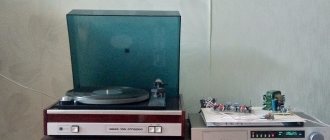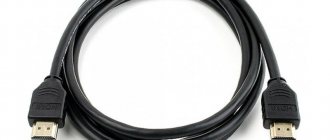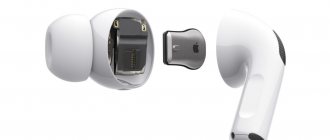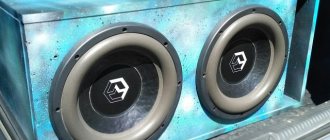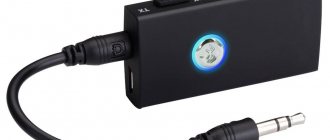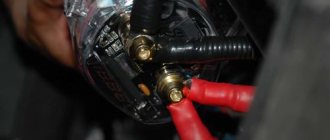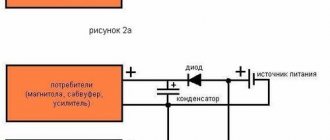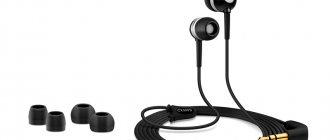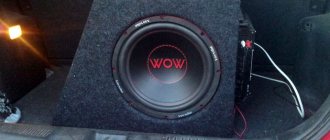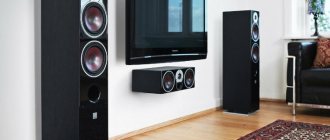M2Tech Young DSD DAC
Manufacturer: M2TECH Srl
www.m2tech.biz
Price: 67,500 rub.
The Italian M2Tech produces a lot of different devices for digital signal processing, some of which are recognized even in the professional audio environment. Among them is the famous Young converter, which in its updated version supports DSD stream. The device is still assembled in a powerful case made of milled aluminum, but now a full-fledged informative display is installed instead of an LED matrix to indicate the current operating mode. Some changes can be found on the back wall. The converter has lost the usual analog output on RCA connectors and is equipped only with a pair of XLRs. For connection to standard equipment, the kit includes appropriate adapters. The digital part includes two main components. The first of these, a powerful Xilinx Spartan signal processor, is responsible for processing the digital signal, which is then converted to analog using a PCM1795 DAC. A signal with a maximum resolution of 32/384 and a DSD stream are available only via USB, for full support of which you need to install a special driver. The model is equipped with a full-featured remote control, capable, in addition to the converter itself, of controlling the playback of major software media players.
The first thing you notice when listening is that the sound of the converter is practically devoid of a digital touch. This, first of all, is expressed in the minimum number of hard components when working with mediocre phonograms. The converter seems to refine even the dirtiest recordings, removing all unnecessary aggression from them. From the point of view of sophistication, the device demonstrates confident presentation of the entire strip. Here you can highlight a polished upper range, smooth mids and expressive structural bass. The lowest part of the range lags somewhat behind in rate of fire, which leaves some imprint on the overall dynamics. The Italian device is distinguished by a rather moderate temperament, sometimes still slightly smoothing out powerful dynamic bursts. The sound stage is simply amazing. Real holography appears on the highest quality recordings. One of the reasons for this is the amazing precision of the instrument positions.
PLEASED
Full-bodied sound, devoid of digital flavor, multi-format.
DISAPPOINTED
Not the most impressive dynamic characteristics.
Compact DACs with USB input || Cambridge Audio DacMagic XS || Tangent Booster DAC2 || Audioquest Dragonfly v.1.2 || NuForce Icon DAC || Furutech GT-40 || Hegel Super || Denon DA-300USB || Parasound Zdac || Musical Fidelity M1DACA || Rega DAC || M2Tech Young DSD || Naim DAC-V1 || Lehmann Audio Linear USB SE || North Star Design Impulso
share
Tags: M2TechPersonal experience
M2Tech Young - DAC comparison test
Every once in a while, a hi-fi component comes along that stands out from the crowd.
53,000 RUB.
In this case, it is a matter of sampling frequency. We've seen many DACs capable of supporting sample rates up to 192 kHz using dedicated digital audio interfaces, but very few that can handle 96 kHz via USB. However, the Italian company M2Tech has significantly expanded this range, offering a sampling rate of up to 384 kHz and 32-bit support for a USB connection.
The device has a good supply of inputs - two coaxial S/PDIF inputs, carefully using one “tulip” and one BNC, optical, AES/EBU and, of course, a USB input. Output is RCA only.
DAC control is simplicity itself. One button is for on/off, the other is for selecting inputs, while the display, quite legible through the somewhat quirky metal grille-like front panel, shows the sample rate. Familiar chips control the digital input, filtering and conversion functions, while the USB input is controlled by special proprietary means assembled on standard digital blocks.
What our listeners were most pleased with was M2Tech Young's focused, distinct, and room-filling sound. It stubbornly follows a dense sonic fabric without losing a single note, and manages at the same time to maintain clean and open detail.
This also has the side effect that the unit can sometimes sound a little bright, but this depends on what kind of material it is playing: music with fewer dynamic moments is actually presented tonally quite calmly and casually, as a couple of tracks with a recording of a church organ proved. On the other hand, the same instrument showed a slight lack of the lowest bass, which is not very noticeable, but is noticeable when directly compared with other participants. Perhaps this is why one of our listeners came to the conclusion that the male voice does not sound entirely impressive.
The sound of the model is invariably characterized by high detail, and the localization of stereo images in space is good in both dimensions. This served as proof that this DAC was the best in the group at creating a real sense of space around the performers, while keeping the images constant throughout, like the ebb and flow of musical tides. As you can safely assume from the comments above, the pacing and coherence are also excellent. Obviously, for a device with an ultra-high sampling rate, any comparisons will be incomplete. But for fun, we experimented with upsampling using Adobe and Izotope software, since we assumed that the possibilities of upsampling and digital filtering were far from being exhausted.
LAB REPORT!
We saw a significant improvement in the performance of the M2Tech Young, using a 24/96 audio signal and achieving 120dB of dynamic range. There were also significant improvements and at the same time imbalances when measuring channel separation: -96 dB (left/right) and -102 dB (right/left). Distortion levels were standard for CD audio and exceptionally low on the 24/96, reaching 0.0007% at 0 dB, 0.004% at -20 dB and 0.4% at -60 dB.
A slightly unkempt frequency response diagram moved the DAC slightly below the average figures in the table, while at higher bitrates and frequencies we saw a smoother curve with the low-pass filter triggering around 30 kHz. The output signals add +8 dB relative to the input, but with only a 2 mV difference between them. During the test, it was revealed that both output channels of this device are the most consistent among all test participants.
Hi-Fi Choice VERDICT
Featuring an outstanding highest sampling rate, this DAC offers energetic yet subtle music playing
PROS: Lively, clear and honest sound with plenty of detail CONS: Sometimes the deepest bass is lacking
WORK QUALITY: 5 out of 5 EXECUTION AND DESIGN: 4 out of 5 FUNCTIONALITY: 4 out of 5
TOTAL: 4 out of 5
IMPARTIAL VERDICT
Adapted from HIGH DEFINITION By RICHARD BLACK, HI-FI CHOICE
Help me choose an uncompromising DAC (up to 1 million rubles)
I really surprised MSB, starting with the Premier, the Reference was completely lackluster... - really different dynamics from the others, a black background, holographic detail and musicality. If I don’t find anything, I’ll worry about how to buy it, but I hope, with everyone’s help, to find something similar in nature in a budget of up to 1 million, incl. boo.
The problem is that in this price segment it is practically impossible to accumulate the necessary wiretapping experience, and to trust the forums... Therefore, I compiled a short list based on studying tons of information, for about six months of daily many hours of study.
Firstly, about the criteria for the sound I need:
1. Hygiene factor - good resolution and transparency, in practical terms this is about 3D holography and separation/design of objects in the scene, at least in the horizontal plane. On my M2 Tech Young for pennies, with Tannoy coaxials there is full holography and even in the vertical plane. At the same time, I don’t hear this effect on practically anything that I was able to listen to live, except MSB. And with the transition to multi-way speakers, this generally becomes a major task.
2. High dynamic resolution - after hearing MSB, it became clear that in this Young, as a point of reference, is clearly inferior. Premier continues to splash black backgrounds into clear, high passages; brightness is not an appropriate characteristic here—it’s more about emotionality.
3. “Fatty”, “meaty” sound - this is called differently. And you practically won’t find this in a cheap figure. They say that this is due to old AD chips, R2R matrices, and/or tube output, but I haven’t found the simple truth. The point is a tight, flowing flow that some describe as “strung to the ear,” in the sense of some commanding, sustained contact with the source of the sound, rather than the uneven artefacts of digital audio. This is about comfort, and about the presence of a foundation, and about fullness, and partly about timbral richness. There is little of this in Young and everything else that has already been listened to.
Accordingly, based on the characteristics described above, as far as possible without personal acquaintance, I selected a list of DACs “recognized” by different categories of enthusiastic people and have long been trying in vain to listen to them:
1.MSB Premier
2. Aqua Formula xHD
3. Lampizator GG, Pacific
4.SW1X 4.5
5. Chord DAVE - obviously not about fat, but deserves its place in any top comparison
6. Playback Design MPD-5/8 - a beast that no one knows, it is mentioned in equal categories with MSB
7. Mola-Mola Tambaqui - a little-known newcomer, with alternative conversion technology, noise and distortion below measurable levels.
In general, there is no information in which league the Ayon DACs are in; perhaps it is worth including in the comparison. I’m not yet sure whether such guys as PS Audio, MyTek, Rockna are worthy of the above three parameters - many criticize them either for their color or for their clearly digital nature.
I’ll tell you right away about the ANTI list:
1. dCs products do not work at all (dry digital, I suspect Dave will go there too), Denafrips Terminator did not show an advantage over Young, Esoteric (dry), Tidal (built into Preos, no 3D at all), Chord (listened to all sorts of Qutest, they simpler and less dynamic than Young).
2. Very controversial opinions and impressions of the AudioNote cult.
3. Never been impressed by big business digital products like McIntosh, AR, Naim, etc.
4. For some time now I have been disappointed in the economical/pretentious options (Gustard, Matrix, GD, Cayin, Shiit, CA, etc.) - all this is “wonderful” for the happy owner and enthusiastic “whistleblowers”, but always on In fact, it loses to serious technology and goes into “I don’t care, I like it.”
I hope for recommendations from those who share the three-parameter approach and have listened to these devices.
M2Tech Young MkIII
The Young MkIII gives you complete control over the music from all your sources to your amplifier and then to your speakers. With a large number of input channels and extensive control options, you always have complete control over your audio system, with full confidence that the quality of the original music material will be delivered to the speakers without any loss. Whether your source is a computer, smartphone, DVD player or CD player, the Young MkIII delivers crisp, vibrant analogue sound from its outputs, with the ability to drive any amplifier. You control it with an encoder on the front panel, using a remote control or your Android smartphone using the same wireless connection, both of which allow audio to be streamed. Audio streaming enthusiasts will enjoy the high quality provided by MQA, while smartphone users will use aptX.
The highest resolution DSD/DXD digital to analog converter. Asynchronous interface Class USB Audio Device 2, S/PDIF, AES/EBU and optical inputs, balanced outputs and adapters for line outputs, remote control, passive anti-alias filter, unique current mode bias cancellation circuit, digitally controlled analog regulator volume, maximum 2.5 Vrms output voltage (SE), 10 Vrms (balanced), HID enabled.
PECULIARITIES
Young DSD has a very high resolution, capable of processing PCM up to 384/32 and DSD up to x128. USB Audio Device 2 interfaces for transmitting high-resolution audio from each computer. S/PDIF, AES/EBU and optical inputs are also provided which process both PCM (up to 192/24) and DSD64. Young DSD inherits the old Young's own resampling scheme for FPGA-based PCM. A 32-bit D/A integrated circuit is used in an unusual mode to provide 705.6/768 kHz internal operation in PCM and 5.6448 MHz in DSD. The synergy between the DAC IC and the custom oversampler allows for exceptionally low noise and THD. High resolution analog volume control IC with digital control. To avoid inserting too many stages in the signal path, which would degrade the sound quality, a unique passive anti-alias filter is used instead of a conventional op-amp buffer, along with a special mode current offset canceling circuit that makes the I/V converter operate with greater symmetry and lower THD. The output voltage can be set by the user to suit the needs of any Young DSD device, be it a preamp, high sensitivity solid state amp or tube power amp. The full remote control allows the user to easily control the Young DSD remotely. The HID protocol makes it possible to control via USB a hardware player installed on a computer. Control is carried out from specially dedicated keys on the remote control.
